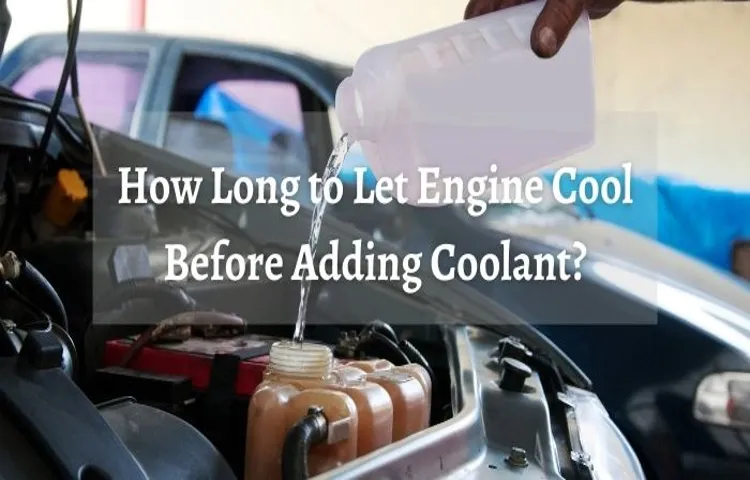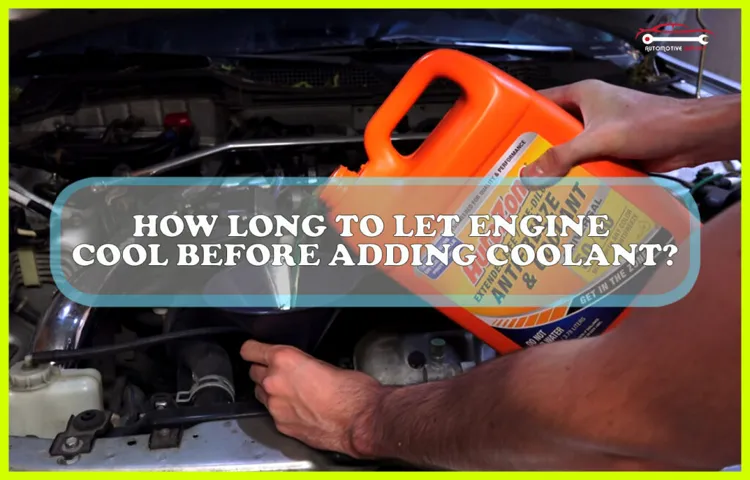Have you ever wondered how long to let your engine sit before checking the coolant? It’s a question that often comes to mind when taking care of your vehicle’s maintenance. Checking your coolant level regularly is essential in preventing your engine from overheating and potentially causing damage to your vehicle. However, it’s crucial to know the right time to check your coolant level without burning yourself or risking injury to the engine.
Think of it as letting the engine “cool down” after a workout; you wouldn’t want to go for a run and immediately start lifting heavy weights. In this blog post, we’ll dive deeper into how long you should wait after turning off your engine before checking your coolant, and why this matters for the health of your vehicle.
Understanding Engine Coolant
When it comes to checking your engine coolant level, it’s important to wait until the engine has cooled down before taking a look. How long to let your engine sit before checking the coolant can depend on a variety of factors, including the type of vehicle and how long it has been running. In general, it’s recommended to wait at least 30 minutes after turning off your car before checking the coolant level.
This allows the engine to cool down and for the coolant to settle in the reservoir, ensuring an accurate reading. It’s also important to check the level regularly and top off as necessary to prevent overheating and potential engine damage. Remember to use the specific type of coolant recommended by your vehicle manufacturer to ensure optimal performance and avoid any potential damage.
Composition of Engine Coolant
Engine coolant, also known as antifreeze, is a mixture of water and ethylene glycol or propylene glycol, which is designed to absorb heat from the engine and dissipate it through the radiator. It is a crucial component of any vehicle’s cooling system as it helps maintain proper engine temperature and prevents overheating. Depending on the manufacturer’s specifications, the coolant may also contain additives such as corrosion inhibitors, lubricants, and pH stabilizers to enhance its performance.
In addition to preventing freezing and overheating, the coolant also helps protect the engine from rust and corrosion, ensuring optimal engine performance and longevity. It is essential to ensure that you use the right type of coolant based on your vehicle’s requirements to avoid engine damage and maintain smooth operation. Regular coolant maintenance, including flushing and replacing, is necessary to prevent engine damage and expensive repairs.

Importance of Engine Coolant
Engine coolant is an essential element in ensuring that your car’s engine is running at optimal levels. It is a liquid that is typically made up of a mixture of water and antifreeze, which is responsible for keeping the engine from overheating. The importance of engine coolant cannot be overstated, as it helps maintain the engine’s temperature within a specific range, preventing it from getting too hot or too cold.
This, in turn, helps the engine operate efficiently and prolongs its lifespan. Without coolant, the engine would overheat, leading to significant damage, such as warped cylinder heads and blown head gaskets, which can be costly to repair. To ensure that your engine coolant is working correctly, it’s crucial to check and replace it regularly.
When the coolant is low, the engine can overheat, and this can affect other components, such as the transmission, causing severe damage. Overall, engine coolant is a crucial component in maintaining your car’s health, and it’s essential to ensure that it’s always at the appropriate levels to avoid any damages or extra costs in the long term.
Checking Engine Coolant Level
If you’re wondering how long to let your engine sit before checking the coolant level, the answer is usually about an hour or two after shutting off the engine. This allows the engine to cool down to a safe and manageable temperature for checking the coolant level. Checking the coolant level is an important part of routine vehicle maintenance as it can indicate potential issues with the radiator or coolant system.
To check the level, simply locate the coolant reservoir and look for the full and low marks on the side of the tank. If the level is below the “full” line, add coolant until it reaches the appropriate level. It’s important to always use the recommended coolant type for your vehicle to ensure proper engine function and to avoid any potential damage or overheating.
Remember to check the coolant level regularly and top off as needed to keep your engine running smoothly.
Step-by-Step Guide
Checking engine coolant level is important for maintaining the proper functioning of your vehicle. First, make sure your car has cooled down completely before opening the hood and locating the coolant reservoir. The coolant level should be between the minimum and maximum markings on the reservoir tank.
If the level is low, remove the cap from the coolant reservoir and add a 50/50 mix of coolant and water until the level reaches the maximum marking. It’s important to use the appropriate coolant for your vehicle; refer to the owner’s manual for specific instructions. Regularly checking the coolant level can prevent engine overheating and potential costly damages.
Make coolant checks a part of your regular vehicle maintenance routine.
Importance of Cool-Down Time
Checking engine coolant level is a crucial step in maintaining the correct temperature of your automobile’s engine. It is especially important to check the coolant level after a long drive or when the engine is hot. The purpose of engine coolant is to absorb the excess heat from the engine, keeping it within a safe temperature range.
If your coolant level is too low, there won’t be enough coolant to absorb the heat, leading to engine overheating and potential damage to your vehicle. To prevent this from happening, it is essential to check the coolant level regularly and add more coolant as needed. A simple way to do this is to locate the coolant reservoir, which is typically a translucent white plastic container marked with “coolant.
” Check the level of the coolant in the reservoir and ensure it is between the minimum and maximum marks. Remember, overheating can lead to costly repair bills, so take a few minutes to check your engine’s coolant level regularly to keep it running smoothly.
Ideal Cool-Down Time for Different Engines
If you’re wondering how long to let your engine sit before checking the coolant, it all depends on the type of engine. For most cars, you should wait at least 30 minutes after turning off the engine before checking the coolant levels. This allows the engine to cool down completely and gives the coolant time to settle.
However, if you’re dealing with a heavy-duty diesel engine, you may need to wait up to an hour or more to ensure the engine is completely cool. If you’re in a hurry and need to check the coolant levels sooner, be sure to use caution and wear protective gloves and eyewear, as the coolant can be hot and under pressure. By waiting an appropriate amount of time before checking your coolant levels, you can ensure the accuracy of your readings and prevent injury.
Gasoline Engines
Gasoline engines require a certain amount of time to cool down after a long drive or operation. The ideal cool-down time varies between engines and is essential to ensure that the engine operates at optimal levels. For instance, a larger engine like those found in trucks and SUVs may require a longer cool-down time of up to 5 minutes, while a smaller car engine may need only 1 to 2 minutes.
Failing to allow an engine proper cool-down could result in damage to engine components, including pistons, gaskets, and cylinder heads. As a general rule of thumb, it is best to let engines cool down to a temperature where it is safe to touch before turning the ignition off. This not only prolongs the life of the engine but also increases efficiency and performance.
So, the next time you turn off your car after a long drive, take a minute or two to let the engine cool down before heading on your way.
Diesel Engines
Diesel engines are popular in the market because of their durability, longevity and fuel efficiency. These engines tend to run hot, creating a lot of heat, and it’s crucial to understand the ideal cool-down time for different engines. The amount of time required for the engine to cool down is dependent on various factors such as engine size, load, type, make, and even the weather.
Typically, it would help if you allowed your engine to run at idle speed for five minutes before turning it off. If you’ve been driving your engine hard, it’s recommended to leave the cold engine running for a few minutes to allow a quick cool-down. In general, letting your engine cool down is crucial because it enhances its reliability, longevity, and efficiency.
You must follow recommended engine cool-down time to ensure your diesel engine lasts for many years and performs at its optimal level.
Conclusion
So, how long should you let your engine cool down before checking the coolant? Well, it’s not quite as simple as setting a timer for a certain number of minutes. Instead, the answer depends on a variety of factors, including the specific make and model of your vehicle, the outside temperature, and how hard you were driving before you turned off the engine. But don’t worry, there’s no need to break out your abacus and slide rule – just give it a few minutes and use your best judgment.
And if you’re ever unsure, just remember this handy mnemonic: ‘When in doubt, wait it out!’
FAQs
1. How long should I wait after turning off the engine before checking the coolant level? Ans: It is recommended to wait at least 10-15 minutes after turning off the engine before checking the coolant level to allow the engine to cool down.2. What happens if I check the coolant level immediately after turning off the engine? Ans: Checking the coolant level immediately after turning off the engine can give you a false reading as the coolant is still circulating and can create a pressure buildup that affects the coolant level.3. Can I check the coolant level when the engine is still warm? Ans: No, it is not recommended to check the coolant level when the engine is still warm as the coolant is still circulating and can give you a false reading.4. How frequently should I check the coolant level in my vehicle? Ans: It is recommended to check the coolant level in your vehicle at least once a month or before long trips.5. What is the normal coolant level in a vehicle? Ans: The normal coolant level in a vehicle should be between the minimum and maximum marks on the coolant reservoir tank.6. What are the signs of low coolant level in a vehicle? Ans: The signs of low coolant level in a vehicle include overheating of the engine, the temperature gauge fluctuating between hot and normal, or a warning light flashing on the dashboard.7. How do I add coolant to my vehicle? Ans: To add coolant to your vehicle, locate the coolant reservoir tank and remove the cap. Add the coolant into the tank until it reaches the maximum level, and then replace the cap tightly.

